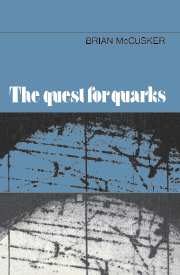6 - Matter and the Universe
Published online by Cambridge University Press: 05 August 2012
Summary
In this chapter I shall tie up a few loose ends and then have a look at the broader implications of all the detailed and complicated work I have described.
First I shall deal with quark confinement. The enormous accelerators at CERN and Fermilabs have not produced quarks in any considerable numbers; in fact most people doubt if any have been produced. So quarks are at least very difficult to extract from nucleons. They are bound (or confined) very strongly in them. Some eminent theoreticians think they are absolutely confined, others are not so sure. But, at least, they are confined to a very considerable extent. Yet when we examine the quarks inside a proton or neutron they appear to be moving around freely – ‘asymptotic freedom’, it is called. How can this be? The answer turned out to be easy, but surprising.
The first force field physicists learned about was gravity. Now the force between two gravitating objects decreases as we move them apart. It is a rapid decrease, getting smaller as the square of the distance between them. If we double the distance, the force is less by a factor of four. When the electrical force was investigated it was found to obey a similar law – the force between two electrical charges varies inversely as the square of the distance between them. There is a difference between the two fields: gravity is always attractive, while the electrical force can be either attractive or repulsive, depending on whether we are dealing with unlike or like charges. But whether it is attractive or repulsive it is always ‘inverse square’.
- Type
- Chapter
- Information
- The Quest for Quarks , pp. 144 - 154Publisher: Cambridge University PressPrint publication year: 1983

